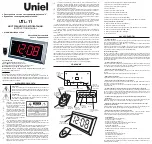
Page - 18
DLS Red connector
plugs into Control
Unit
Page - 27
Green wire
to the "Motor"
side of the
cut “lock” wire.
Blue wire
to the "Motor"
side of the
cut “unlock” wire.
Cut both the “lock”
and “unlock” wires.*
Brown wire
to the "Switch"
side of the cut
“unlock” wire.
White wire
to the "Switch"
side of the
cut “lock” wire.
Violet wire to
Constant
(+) 12 Volts.
Lock
Unlock
Driver
Doorlock
Switch
Lock
Unlock
Passenger
Doorlock
Switch
Cutting only one of two wires can cause
misleading test results. For example, if
only the “lock” wire is cut, the “switch”
side of the cut will show (+)12 Volts when
the primary switch is pushed to the "lock"
position and the “motor” side of the cut
will show (+)12 Volts when the primary
switch is pushed to the "unlock" position.
Passenger
Motors
Driver
Motors
DLS
Relay
Relay
5 Wire Reversal Doorlocks
Using The Optional
DLS & 2 Relays
(wire colors are
the same for other
Omega interfaces)
Configuring An Optional Relay:
The Blue/Black Horn output wire has a
250mA capacity, which, if exceeded, can damage the security system control mod-
ule. In certain situations, such as a vehicle which lacks a horn relay or installing
multiple optional sirens, an optional SPDT relay is required. The diagram on the
following page shows how to configure the relay.
Blue/Black Wire - (Horn Honk Output; Programmable for
Unlock, Ignition, or Accessory):
The Blue/Black wire is a Negative out-
put (at 250mA) for the system's audible output, and is defaulted to operate the
vehicle's existing horn. Installer Feature #3 can be used to change this output’s
operation. When used as a horn output, user feature #10 offers four settings for
adjusting the horn's confirmation chirps.
CAUTION! Avoid the airbag circuit! This is one of the few legitimate uses for
a standard test light in a modern vehicle; use a digital multimeter (DMM) to
identify the horn wire first.
Probing an airbag circuit with a standard test light can cause the Airbag to
deploy!
Horn CONNECTION: The Blue/Black wire may be connected directly to the
vehicle's horn switch wire, provided the circuit operates with 250mA of current or
less. The horn wire is typically found around the steering column; the correct wire
will show Positive 12 Volts normally, and continuity to ground when the horn is
being sounded. Once the vehicle's horn wire is identified using a digital multi-
meter, you can probe the wire with a standard test light connected to Negative
chassis ground. If the horn sounds when probed, a direct connection may be made.
If not, use the diagram on the following page to configure an optional relay.
The horn chirp volume may set at one of four levels. When programming
user feature #10, press the remote transmitter's UNLOCK button for Softest
chirps, press the LOCK button for Medium Soft chirps, press the “||” button
for Medium Loud chirps, or press the “|||” button for the Loudest chirps.
Another alternative is to disconnect the horns, then operate the horn switch.
Typically, a "clicking" sound from the vehicle can heard as the horn button is
pressed, and released, which confirms the presence of an existing horn relay. Yet
another alternative is to consult a wiring schematic of the vehicle in question to
determine if an existing horn relay is present.





































